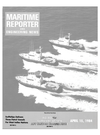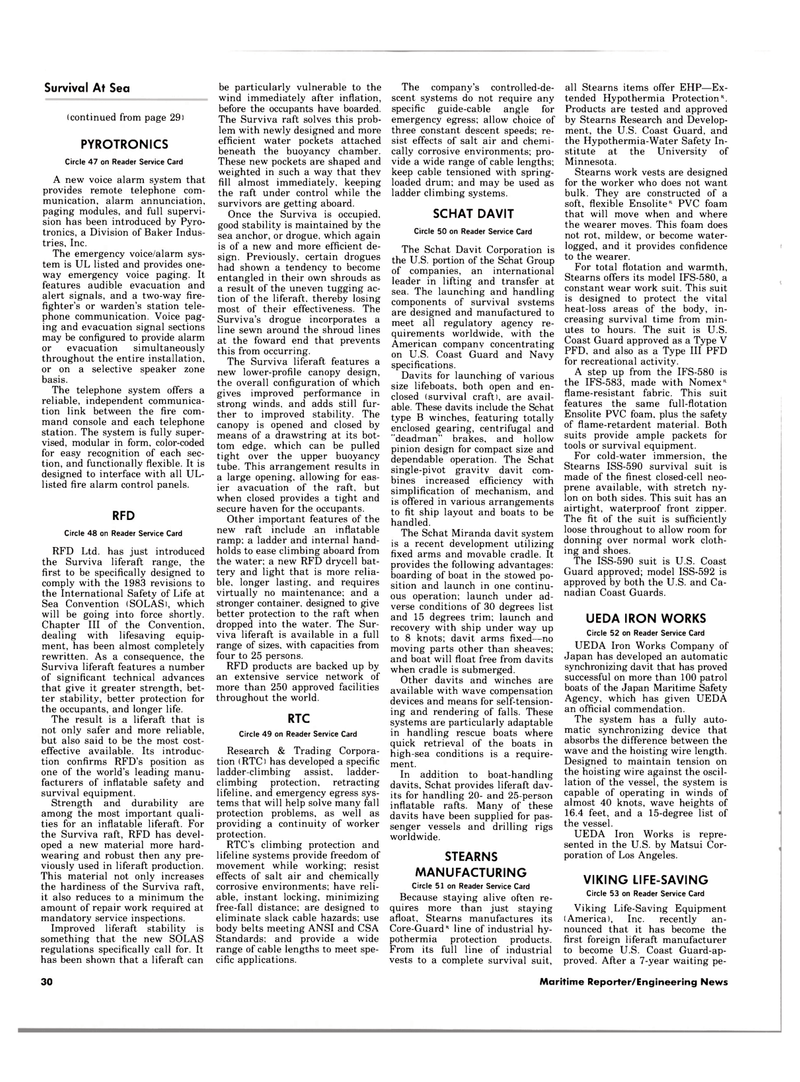
Page 28: of Maritime Reporter Magazine (April 15, 1984)
Read this page in Pdf, Flash or Html5 edition of April 15, 1984 Maritime Reporter Magazine
The company's controlled-de- scent systems do not require any specific guide-cable angle for emergency egress; allow choice of three constant descent speeds; re- sist effects of salt air and chemi- cally corrosive environments; pro- vide a wide range of cable lengths; keep cable tensioned with spring- loaded drum; and may be used as ladder climbing systems.
SCHAT DAVIT
Circle 50 on Reader Service Card
The Schat Davit Corporation is the U.S. portion of the Schat Group of companies, an international leader in lifting and transfer at sea. The launching and handling components of survival systems are designed and manufactured to meet all regulatory agency re- quirements worldwide, with the
American company concentrating on U.S. Coast Guard and Navy specifications.
Davits for launching of various size lifeboats, both open and en- closed (survival crafti, are avail- able. These davits include the Schat type B winches, featuring totally enclosed gearing, centrifugal and "deadman" brakes, and hollow pinion design for compact size and dependable operation. The Schat single-pivot gravity davit com- bines increased efficiency with simplification of mechanism, and is offered in various arrangements to fit ship layout and boats to be handled.
The Schat Miranda davit system is a recent development utilizing fixed arms and movable cradle. It provides the following advantages: boarding of boat in the stowed po- sition and launch in one continu- ous operation; launch under ad- verse conditions of 30 degrees list and 15 degrees trim; launch and recovery with ship under way up to 8 knots; davit arms fixed—no moving parts other than sheaves; and boat will float free from davits when cradle is submerged.
Other davits and winches are available with wave compensation devices and means for self-tension- ing and rendering of falls. These systems are particularly adaptable in handling rescue boats where quick retrieval of the boats in high-sea conditions is a require- ment.
In addition to boat-handling davits, Schat provides liferaft dav- its for handling 20- and 25-person inflatable rafts. Many of these davits have been supplied for pas- senger vessels and drilling rigs worldwide.
STEARNS all Stearns items offer EHP—Ex- tended Hypothermia Protection".
Products are tested and approved by Stearns Research and Develop- ment, the U.S. Coast Guard, and the Hypothermia-Water Safety In- stitute at the University of
Minnesota.
Stearns work vests are designed for the worker who does not want bulk. They are constructed of a soft, flexible Ensolite" PVC foam that will move when and where the wearer moves. This foam does not rot, mildew, or become water- logged, and it provides confidence to the wearer.
For total flotation and warmth,
Stearns offers its model IFS-580, a constant wear work suit. This suit is designed to protect the vital heat-loss areas of the body, in- creasing survival time from min- utes to hours. The suit is U.S.
Coast Guard approved as a Type V
PFD, and also as a Type III PFD for recreational activity.
A step up from the IFS-580 is the IFS-583, made with Nomex" flame-resistant fabric. This suit features the same full-flotation
Ensolite PVC foam, plus the safety of flame-retardent material. Both suits provide ample packets for tools or survival equipment.
For cold-water immersion, the
Stearns ISS-590 survival suit is made of the finest closed-cell neo- prene available, with stretch ny- lon on both sides. This suit has an airtight, waterproof front zipper.
The fit of the suit is sufficiently loose throughout to allow room for donning over normal work cloth- ing and shoes.
The ISS-590 suit is U.S. Coast
Guard approved; model ISS-592 is approved by both the U.S. and Ca- nadian Coast Guards.
UEDA IRON WORKS
Circle 52 on Reader Service Card
UEDA Iron Works Company of
Japan has developed an automatic synchronizing davit that has proved successful on more than 100 patrol boats of the Japan Maritime Safety
Agency, which has given UEDA an official commendation.
The system has a fully auto- matic synchronizing device that absorbs the difference between the wave and the hoisting wire length.
Designed to maintain tension on the hoisting wire against the oscil- lation of the vessel, the system is capable of operating in winds of almost 40 knots, wave heights of 16.4 feet, and a 15-degree list of the vessel.
UEDA Iron Works is repre- sented in the U.S. by Matsui Cor- poration of Los Angeles.
Survival At Sea (continued from page 291
PYROTRONICS
Circle 47 on Reader Service Card
A new voice alarm system that provides remote telephone com- munication, alarm annunciation, paging modules, and full supervi- sion has been introduced by Pyro- tronics, a Division of Baker Indus- tries, Inc.
The emergency voice/alarm sys- tem is UL listed and provides one- way emergency voice paging. It features audible evacuation and alert signals, and a two-way fire- fighter's or warden's station tele- phone communication. Voice pag- ing and evacuation signal sections may be configured to provide alarm or evacuation simultaneously throughout the entire installation, or on a selective speaker zone basis.
The telephone system offers a reliable, independent communica- tion link between the fire com- mand console and each telephone station. The system is fully super- vised, modular in form, color-coded for easy recognition of each sec- tion, and functionally flexible. It is designed to interface with all UL- listed fire alarm control panels.
RFD
Circle 48 on Reader Service Card
RFD Ltd. has just introduced the Surviva liferaft range, the first to be specifically designed to comply with the 1983 revisions to the International Safety of Life at
Sea Convention (SOLASi, which will be going into force shortly.
Chapter III of the Convention, dealing with lifesaving equip- ment, has been almost completely rewritten. As a consequence, the
Surviva liferaft features a number of significant technical advances that give it greater strength, bet- ter stability, better protection for the occupants, and longer life.
The result is a liferaft that is not only safer and more reliable, but also said to be the most cost- effective available. Its introduc- tion confirms RFD's position as one of the world's leading manu- facturers of inflatable safety and survival equipment.
Strength and durability are among the most important quali- ties for an inflatable liferaft. For the Surviva raft, RFD has devel- oped a new material more hard- wearing and robust then any pre- viously used in liferaft production.
This material not only increases the hardiness of the Surviva raft, it also reduces to a minimum the amount of repair work required at mandatory service inspections.
Improved liferaft stability is something that the new SOLAS regulations specifically call for. It has been shown that a liferaft can be particularly vulnerable to the wind immediately after inflation, before the occupants have boarded.
The Surviva raft solves this prob- lem with newly designed and more efficient water pockets attached beneath the buoyancy chamber.
These new pockets are shaped and weighted in such a way that they fill almost immediately, keeping the raft under control while the survivors are getting aboard.
Once the Surviva is occupied, good stability is maintained by the sea anchor, or drogue, which again is of a new and more efficient de- sign. Previously, certain drogues had shown a tendency to become entangled in their own shrouds as a result of the uneven tugging ac- tion of the liferaft. thereby losing most of their effectiveness. The
Surviva's drogue incorporates a line sewn around the shroud lines at the foward end that prevents this from occurring.
The Surviva liferaft features a new lower-profile canopy design, the overall configuration of which gives improved performance in strong winds, and adds still fur- ther to improved stability. The canopy is opened and closed by means of a drawstring at its bot- tom edge, which can be pulled tight over the upper buoyancy tube. This arrangement results in a large opening, allowing for eas- ier avacuation of the raft, but when closed provides a tight and secure haven for the occupants.
Other important features of the new raft include an inflatable ramp: a ladder and internal hand- holds to ease climbing aboard from the water; a new RFD drycell bat- tery and light that is more relia- ble, longer lasting, and requires virtually no maintenance; and a stronger container, designed to give better protection to the raft when dropped into the water. The Sur- viva liferaft is available in a full range of sizes, with capacities from four to 25 persons.
RFD products are backed up by an extensive service network of more than 250 approved facilities throughout the world.
RTC
Circle 49 on Reader Service Card
Research & Trading Corpora- tion (RTC) has developed a specific ladder-climbing assist, ladder- climbing protection, retracting lifeline, and emergency egress sys- tems that will help solve many fall protection problems, as well as providing a continuity of worker protection.
RTC's climbing protection and lifeline systems provide freedom of movement while working; resist effects of salt air and chemically corrosive environments; have reli- able, instant locking, minimizing free-fall distance; are designed to eliminate slack cable hazards; use body belts meeting ANSI and CSA
Standards: and provide a wide range of cable lengths to meet spe- cific applications.
MANUFACTURING
Circle 51 on Reader Service Card
Because staying alive often re- quires more than just staying afloat, Stearns manufactures its
Core-Guard" line of industrial hy- pothermia protection products.
From its full line of industrial vests to a complete survival suit,
VIKING LIFE-SAVING
Circle 53 on Reader Service Card
Viking Life-Saving Equipment (America), Inc. recently an- nounced that it has become the first foreign liferaft manufacturer to become U.S. Coast Guard-ap- proved. After a 7-year waiting pe- 30 Maritime Reporter/Engineering News

 27
27

 29
29
